《人类减贫的中国实践》白皮书(双语全文)
新华网 2021-04-06 14:28

三、实施精准扶贫方略
III. The Strategy of Targeted Poverty Alleviation
对于贫困人口规模庞大的国家,找准贫困人口、实施扶真贫是普遍性难题。脱贫攻坚贵在精准、重在精准,成败之举在于精准。中国在脱贫攻坚实践中,积极借鉴国际经验,紧密结合中国实际,创造性地提出并实施精准扶贫方略,做到扶持对象、项目安排、资金使用、措施到户、因村派人、脱贫成效“六个精准”,实施发展生产、易地搬迁、生态补偿、发展教育、社会保障兜底“五个一批”,解决好扶持谁、谁来扶、怎么扶、如何退、如何稳“五个问题”,增强了脱贫攻坚的目标针对性,提升了脱贫攻坚的整体效能。
Identifying those truly in need is a universal problem in countries with a large population in poverty. Accurate identification of the poor and targeted measures is central to any effort to eradicate poverty. In its poverty elimination effort, China has actively learned from international experience, fully considered its actual conditions, and launched a series of guidelines and measures to increase efficiency, summarized as accomplishing "Targeted Efforts in Six Areas"[ This refers to efforts to identify the poor accurately, arrange targeted programs, utilize capital efficiently, take household-based measures, dispatch first Party secretaries based on village conditions, and achieve the set goals.], taking "Five Measures for Poverty Eradication"[ The measures include: boosting the economy to provide more job opportunities, relocating poor people from inhospitable areas, compensating for economic losses associated with reducing ecological damage, improving education in impoverished areas, and providing subsistence allowances for those unable to shake off poverty through their own efforts alone. ], and addressing "Five Questions in Poverty Alleviation"[ This refers to these questions: who should help, who should be helped, how to help, how to evaluate whether someone has emerged from poverty, and how to ensure those people stay free from poverty. ].
(一)精准识别、建档立卡,解决“扶持谁”的问题
1. Identifying People in Need to Know Whom to Help
扶贫必先识贫。中国贫困人口规模大、结构复杂,实现精准扶贫首先要精准识贫。科学制定贫困识别的标准和程序,组织基层干部进村入户,摸清贫困人口分布、致贫原因、帮扶需求等情况。贫困户识别以农户收入为基本依据,综合考虑住房、教育、健康等情况,通过农户申请、民主评议、公示公告、逐级审核的方式,进行整户识别;贫困村识别综合考虑行政村贫困发生率、村民人均纯收入和村集体经济收入等情况,按照村委会申请、乡政府审核公示、县级审定公告等程序确定。对识别出的贫困村和贫困人口建档立卡,建立起全国统一的扶贫信息系统。组织开展“回头看”,实行动态管理,及时剔除识别不准人口、补录新识别人口,提高识别准确率。建档立卡在中国扶贫史上第一次实现贫困信息精准到村到户到人,精确瞄准了脱贫攻坚的对象,第一次逐户分析致贫原因和脱贫需求,第一次构建起国家扶贫信息平台,为实施精准扶贫精准脱贫提供了有力的数据支撑。
To help the poor, we must know who they are. China had a large poor population, which was complex in composition. China has developed a set of standards and procedures to accurately identify the poor, and grassroots officials have spent time in villages analyzing the distribution of the poor population, the causes of their poverty, and their needs. Poor households are identified primarily based on their incomes, with consideration given to other factors such as housing, education and health. Household applications for poverty registration are discussed and reviewed, disclosed for public supervision, and then evaluated by each level of administration. For administrative villages applying to be registered, consideration is given to the incidence of poverty, the per capita net income of the villagers, and income from businesses run by village collectives. Applications are filed by the village committee, reviewed and disclosed by the township government, and examined by the county government before the results are made public. The individuals and villages confirmed as poor are then registered and a file is created in the national poverty alleviation information system. Dynamic management of the poor population has been strengthened to remove those who have been wrongly identified and to add those newly identified, with an emphasis on accuracy. Through this registration system, for the first time in the history of poverty alleviation, China has identified every poor individual in every village, every poor household has the causes of their poverty and their needs registered with the government. The national information platform on poverty alleviation provides powerful IT support for targeted measures to realize the set goals.
(二)加强领导、建强队伍,解决“谁来扶”的问题
2. Strengthening Leadership and Team-building to Know How to Offer Help
脱贫攻坚涉及面广、要素繁多、极其复杂,需要强有力的组织领导和贯彻执行。充分发挥党的政治优势、组织优势,建立中央统筹、省负总责、市县抓落实的脱贫攻坚管理体制和片为重点、工作到村、扶贫到户的工作机制,构建起横向到边、纵向到底的工作体系。各级党委充分发挥总揽全局、协调各方的作用,执行脱贫攻坚一把手负责制,中西部22个省份党政主要负责同志向中央签署责任书、立下军令状,省市县乡村五级书记一起抓。脱贫攻坚期内,贫困县党委政府正职保持稳定。有脱贫任务的地区,倒排工期、落实责任,抓紧施工、强力推进。脱贫攻坚任务重的地区,把脱贫攻坚作为头等大事和第一民生工程,以脱贫攻坚统揽经济社会发展全局。实行最严格的考核评估和监督检查,组织脱贫攻坚专项巡视,开展扶贫领域腐败和作风问题专项治理(专栏5),加强脱贫攻坚督导和监察(专栏6),确保扶贫工作务实、脱贫过程扎实、脱贫结果真实,使脱贫攻坚成果经得起实践和历史检验。建立健全干部担当作为的激励和保护机制,加大关心关爱干部力度,树立正确用人导向,引导广大干部在决胜脱贫攻坚中奋发有为、履职尽责。加强基层扶贫队伍建设,普遍建立干部驻村帮扶工作队制度,按照因村派人、精准选派的原则,选派政治素质好、工作能力强、作风实的干部驻村扶贫。广大驻村干部牢记使命、不负重托,心系贫困群众,扎根基层扶贫一线,倾心倾力帮助贫困群众找出路、谋发展、早脱贫。从2013年开始向贫困村选派第一书记和驻村工作队,到2015年,实现每个贫困村都有驻村工作队、每个贫困户都有帮扶责任人。截至2020年底,全国累计选派25.5万个驻村工作队、300多万名第一书记和驻村干部,同近200万名乡镇干部和数百万村干部一道奋战在扶贫一线。
Poverty eradication work covers a wide range of areas and is extremely complex, thus requiring rigorous organization, leadership, and implementation. Relying on the CPC's political and organizational strength, China has established a poverty eradication management network with the central government acting as coordinator, provincial governments taking overall responsibility, and city and county governments overseeing implementation. The network covers all poor areas and officials are sent to villages to help every needy household. Party committees at all levels have assumed an overall coordinating role and assigned top officials to take charge of poverty eradication affairs. The leading officials of 22 provinces and equivalent administrative units in central and western China signed written pledges to the Party Central Committee, and Party secretaries at the five administrative levels of province, city, county, township and village have worked towards the same goal. During the poverty eradication campaign, Party committee secretaries and county governors have been required to remain unchanged in their posts. Areas tasked with poverty elimination worked out timetables with a clear division of responsibilities and pressed forward with implementation. In places where the work was particularly difficult, the fight against poverty became the top priority of social and economic development. Through the strictest possible evaluation and supervision, as well as specialized inspection tours, China has addressed any corruption and misconduct in poverty alleviation with rigor (Box 5), and strengthened the evaluation and supervision of results to ensure solid and authentic outcomes (Box 6) that can survive the test of time and practice. China has improved the incentives for encouraging officials to fulfill responsibilities and undertake initiatives, and the relevant mechanisms to protect their position. By giving more attention to and caring for officials and establishing the right approach to their selection and appointment, the government has given them the incentive to fulfill their duties and do their best in the final fight against poverty. China has strengthened its team of grassroots officials working in poverty alleviation, and formed resident working teams to assign officials to villages where they could be most useful. Officials on the resident working teams must be politically reliable and professional, and have a can-do approach to their work. Officials on these teams have dedicated themselves to their mission and fulfilled their duties, committing themselves to helping those in need on the front line of fighting poverty, and giving their all to help the poor find ways to emerge from poverty and seek development. The first group of first secretaries and resident working teams were dispatched to poor villages in 2013. By 2015, all poor villages had resident working teams, and every poor household a contact official in charge of poverty elimination. As of the end of 2020, 255,000 resident teams and more than 3 million officials had been dispatched as first secretaries and resident officials to poor villages, fighting on the front line of poverty alleviation alongside nearly 2 million township officials and millions of village officials.
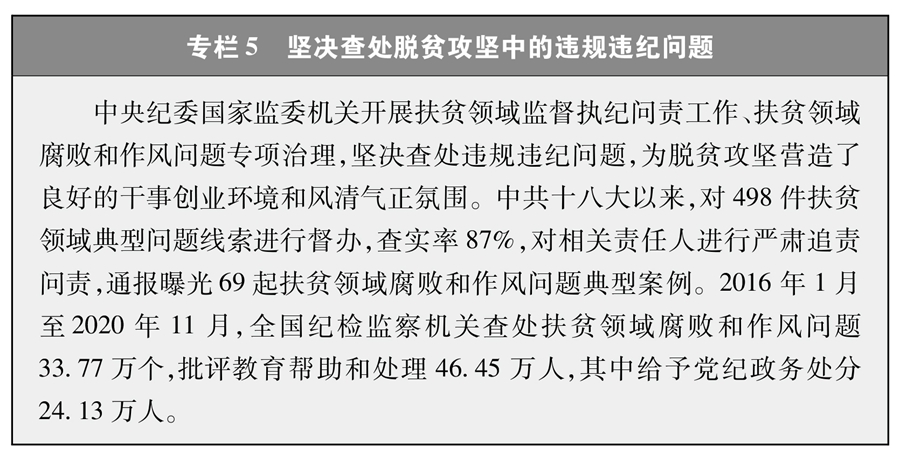

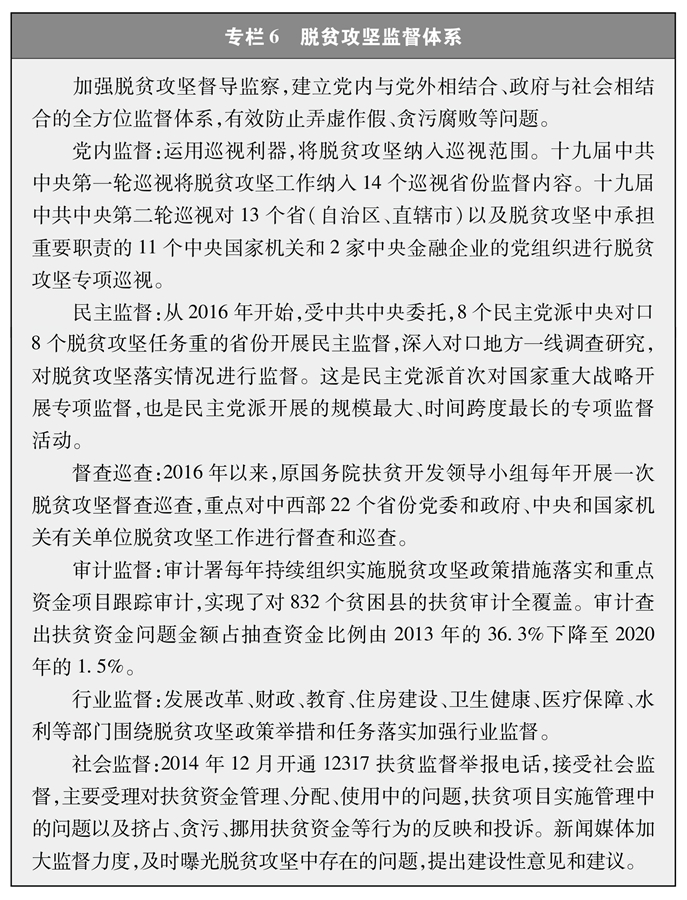
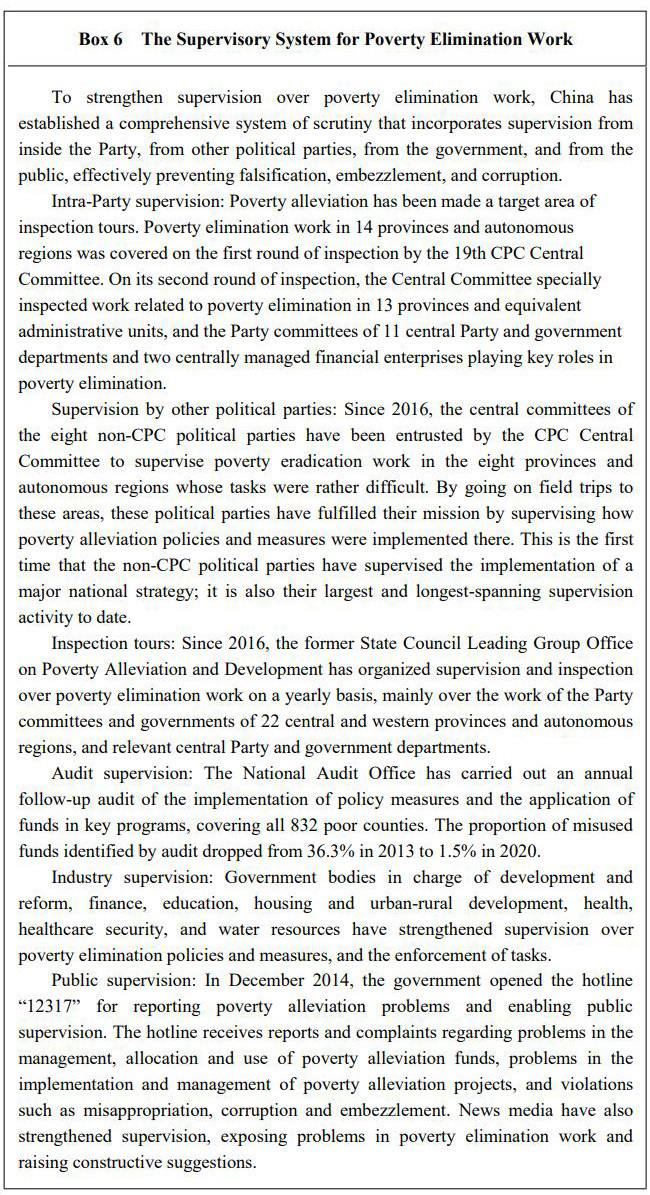
(三)区分类别、靶向施策,解决“怎么扶”的问题
3. Applying Targeted Measures for Different Groups to Know How to Help
贫困的类型和原因千差万别,开对“药方子”才能拔掉“穷根子”。中国在减贫实践中,针对不同情况分类施策、对症下药,因人因地施策,因贫困原因施策,因贫困类型施策,通过实施“五个一批”实现精准扶贫。
There are many different types of poverty and the causes vary from case to case. We cannot address the root cause without the right remedies. In practice, China has adopted categorized and targeted measures to reduce poverty, based on the situation of individual households, local conditions, and the causes for and types of poverty. These targeted measures include: boosting the economy to provide more job opportunities, relocating poor people from inhospitable areas, compensating for economic losses associated with reducing ecological damage, improving education in impoverished areas, and providing subsistence allowances for those unable to shake off poverty through their own efforts alone.
发展生产脱贫一批。发展产业是脱贫致富最直接、最有效的办法,也是增强贫困地区造血功能、帮助贫困群众就地就业的长远之计。支持和引导贫困地区因地制宜发展特色产业,鼓励支持电商扶贫、光伏扶贫、旅游扶贫等新业态新产业发展(专栏7),依托东西部扶贫协作推进食品加工、服装制造等劳动密集型产业梯度转移,一大批特色优势产业初具规模,增强了贫困地区经济发展动能。累计建成各类产业基地超过30万个,形成了特色鲜明、带贫面广的扶贫主导产业,打造特色农产品品牌1.2万个。发展市级以上龙头企业1.44万家、农民合作社71.9万家,72.6%的贫困户与新型农业经营主体建立了紧密型的利益联结关系。产业帮扶政策覆盖98.9%的贫困户,有劳动能力和意愿的贫困群众基本都参与到产业扶贫之中。扎实推进科技扶贫,建立科技帮扶结对7.7万个,选派科技特派员28.98万名,投入资金200多亿元,实施各级各类科技项目3.76万个,推广应用先进实用技术、新品种5万余项,支持贫困地区建成创新创业平台1290个。为贫困户提供扶贫小额信贷支持(专栏8),培育贫困村创业致富带头人,建立完善带贫机制,鼓励和带领贫困群众发展产业增收致富。
First, boosting the economy to provide more job opportunities. Poverty alleviation through economic development is the most direct and effective method, the fundamental way to give poor areas the capacity for independent development and help the poor find employment locally. With this in mind, China has supported and guided poor areas in developing economic activities geared to their available resources, and encouraged poverty alleviation through new forms of business and new industries such as e-commerce, photovoltaic (PV) power generation and tourism, and through the consumption of products and services from poor areas (Box 7). Relying on collaboration on poverty alleviation between the eastern and western regions, China has facilitated the transfer of food processing, clothes manufacturing, and other labor-intensive industries from the east to the west. With the growth of such specialty industries, poor areas have gained economic momentum. More than 300,000 industrial bases have been built, leading to the creation of new industries with distinctive features and greater capacity to facilitate poverty alleviation efforts. China has created 12,000 local agroproduct brands, 14,400 leading enterprises above the city level, and 719,000 rural cooperatives operated by farmers. A total of 72.6% of poor households have formed close ties with new types of agribusiness entities, and almost every poor household has been covered by policy support for boosting the economy. Almost all poor people with the ability and intention to work have joined the collective endeavor. Solid progress has been made in poverty alleviation through the development of science and technology. A total of 1,290 innovative platforms and business startups have been set up, and 77,000 people have been paired up with professionals to receive guidance on new technology in impoverished regions. With a team of 289,800 technicians and a fund of over RMB20 billion, China has launched 37,600 high-tech programs of all kinds and at all levels and introduced more than 50,000 advanced applied technologies and new, improved breeds. Poor households have received financial support such as small loans (Box 8). In poor villages, entrepreneurial individuals have been encouraged to start businesses and given support to help and lead others out of poverty.
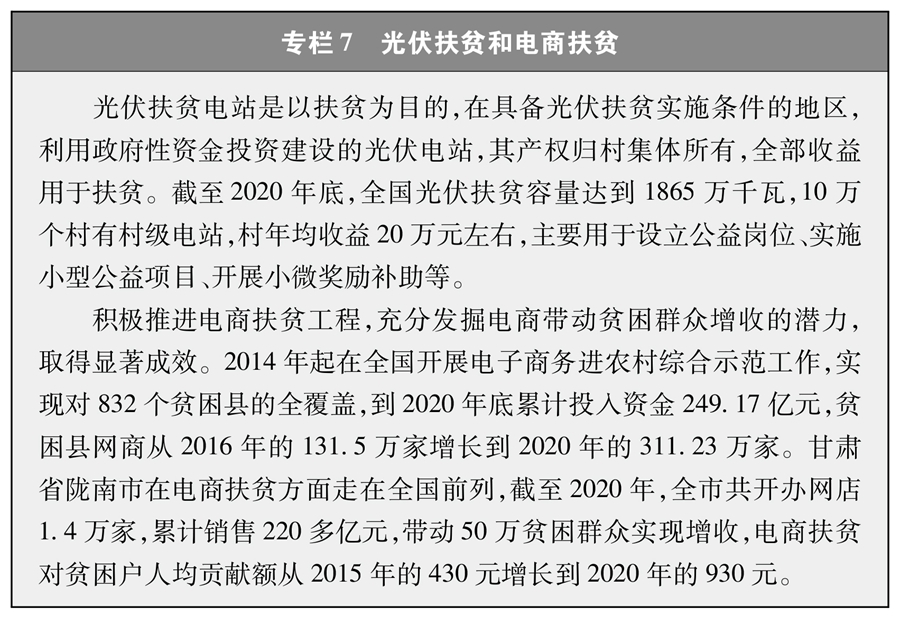
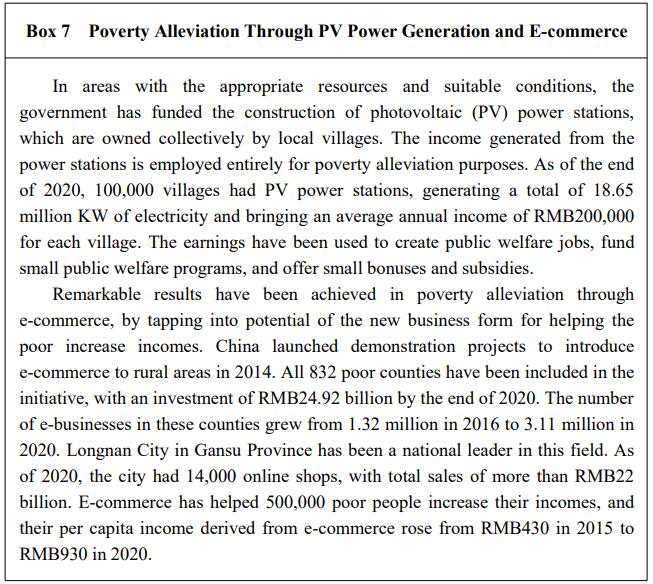
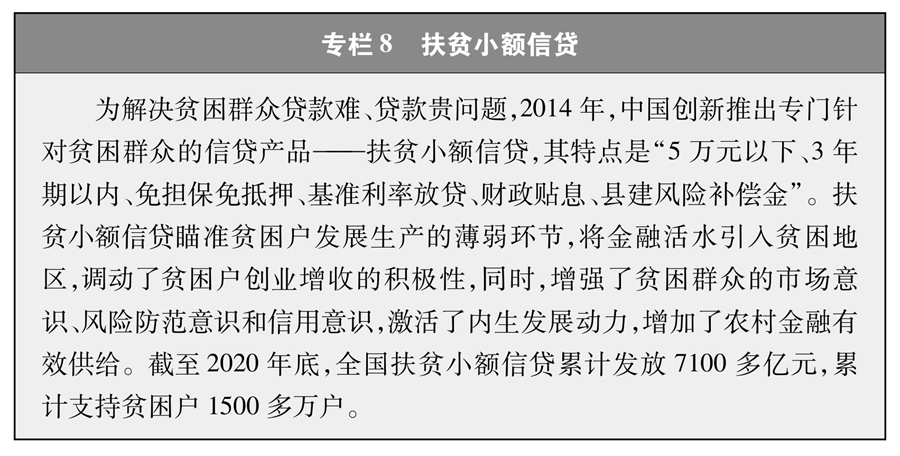
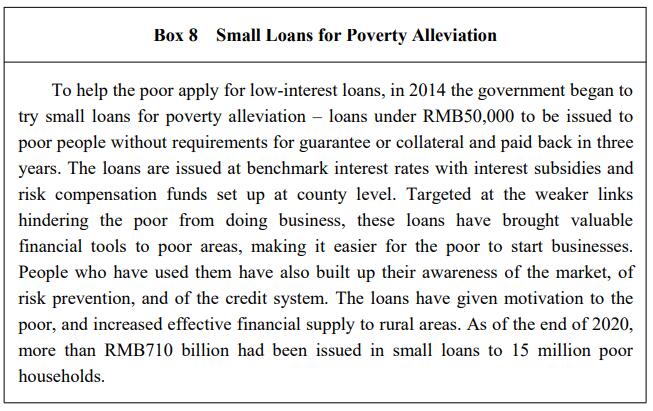
易地搬迁脱贫一批。对生活在自然环境恶劣、生存条件极差、自然灾害频发地区,很难实现就地脱贫的贫困人口,实施易地扶贫搬迁(专栏9)。充分尊重群众意愿,坚持符合条件和群众自愿原则,加强思想引导,不搞强迫命令。全面摸排搬迁对象,精心制定搬迁规划,合理确定搬迁规模,有计划有步骤稳妥实施。960多万生活在“一方水土养不好一方人”地区的贫困人口通过易地搬迁实现脱贫。对搬迁后的旧宅基地实行复垦复绿,改善迁出区生态环境。加强安置点配套设施和产业园区、扶贫车间等建设,积极为搬迁人口创造就业机会,保障他们有稳定的收入,同当地群众享受同等的基本公共服务,确保搬得出、稳得住、逐步能致富。
Second, relocating poor people from inhospitable areas. Some people lived in uninhabitable areas suffering from harsh natural conditions and subject to frequent natural disasters. It would be very hard for them to shake off poverty if they remained where they were, so the government relocated them to other areas (Box 9). The government respected these people's wishes, and only relocated those who were eligible and agreed to move. The reasons for relocation were explained to them but no coercion was used. The conditions and needs of target relocation groups were given full consideration, the scale of relocation was determined through research, and feasible plans were worked out and implemented in steps. As a result, more than 9.6 million people from inhospitable areas have shaken off poverty through relocation. Their former homes have been turned into farmland or planted with trees, to improve the eco-environment in these areas. In the resettlement sites, support facilities, industrial parks, and workshops have been built to create jobs for the relocated population, to ensure that they have stable incomes and equitable access to basic public services. Measures have been taken to ensure smooth relocation and resettlement, and make sure that those involved have the means to better themselves.
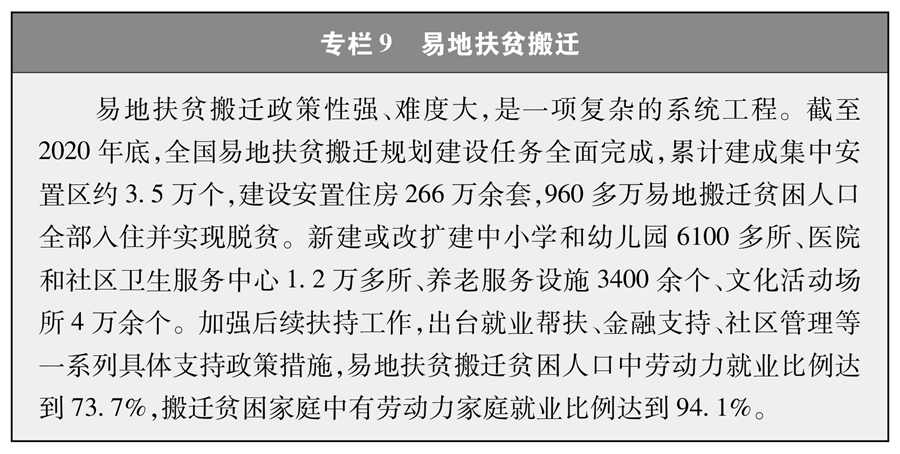
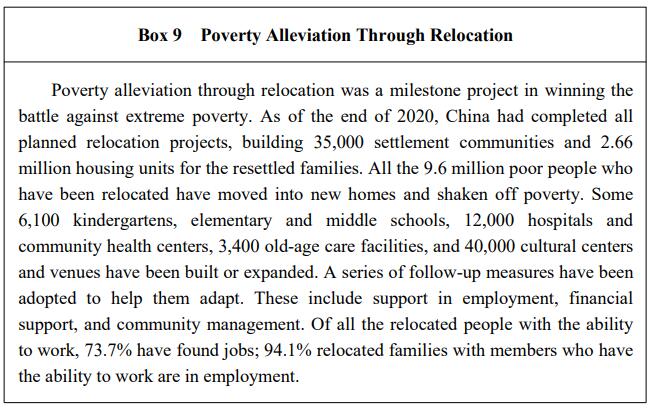
生态补偿脱贫一批。践行“绿水青山就是金山银山”理念,坚持脱贫攻坚与生态保护并重,在加大贫困地区生态保护修复力度的同时,增加重点生态功能区转移支付,不断扩大政策实施范围,让有劳动能力的贫困群众就地转为护林员等生态保护人员。2013年以来,贫困地区实施退耕还林还草7450万亩,选聘110多万贫困群众担任生态护林员,建立2.3万个扶贫造林(种草)专业合作社(队)。贫困群众积极参与国土绿化、退耕还林还草等生态工程建设和森林、草原、湿地等生态系统保护修复工作,发展木本油料等经济林种植及森林旅游,不仅拓宽了增收渠道,也明显改善了贫困地区生态环境,实现了“双赢”。
Third, shaking off poverty through compensations for economic losses associated with reducing ecological damage and getting eco-jobs. Clear waters and green mountains are invaluable assets. Laying equal emphasis on poverty alleviation and eco-conservation, China has strengthened ecological restoration and environmental protection in poor areas, increased government transfer payments to key eco-areas, and expanded the scope of those eligible for preferential policies. Poor people with the ability to work have thus been employed in eco-work, for example as forest rangers. Since 2013, a total of 4.97 million ha of farmland in poor areas has been returned to forest and grassland. A total of 1.1 million poor people have become forest rangers, and 23,000 poverty alleviation afforestation cooperatives/teams have been formed. By participating in projects for afforestation, turning reclaimed farmlands into forests or grasslands, restoring and protecting forests, grasslands and wetlands, and growing woody oil plants and working in forest tourism, the poor population have increased their incomes and made a major contribution to improving the eco-environment in poor areas, with mutually beneficial results.
发展教育脱贫一批。坚持再穷不能穷教育、再穷不能穷孩子,加强教育扶贫,不让孩子输在起跑线上,努力让每个孩子都有人生出彩的机会,阻断贫困代际传递(专栏10)。持续提升贫困地区学校、学位、师资、资助等保障能力,20多万名义务教育阶段的贫困家庭辍学学生全部返校就读,全面实现适龄少年儿童义务教育有保障。实施定向招生、学生就业、职教脱贫等倾斜政策,帮助800多万贫困家庭初高中毕业生接受职业教育培训、514万名贫困家庭学生接受高等教育,重点高校定向招收农村和贫困地区学生70多万人,拓宽贫困学生纵向流动渠道。开展民族地区农村教师和青壮年农牧民国家通用语言文字培训,累计培训350万余人次,提升民族地区贫困人口就业能力。“学前学会普通话”行动先后在四川省凉山彝族自治州和乐山市马边彝族自治县、峨边彝族自治县、金口河区开展试点,覆盖43万学龄前儿童,帮助他们学会普通话。
Fourth, improving education in impoverished areas. Through education, poverty can be prevented from passing down from generation to generation (Box 10). The government has continued to increase support for schools in poor areas to improve their conditions, standard of teaching, faculties and financial resources. The state ensures compulsory education for all school-age children. All the 200,000 dropouts from compulsory education coming from poor families have returned to school. Favorable policies have been leveraged to enroll more poor students from designated areas, expand employment for graduates, and help students shake off poverty through vocational education. More than 8 million middle and high school graduates from poor families have received vocational training, 5.14 million poor students have received higher education, and key institutions of higher learning have admitted some 700,000 students from designated rural and poor areas. All this has opened up more channels for poor students to emerge from poverty and move upwards in society. The government has offered training on standard spoken and written Chinese language to 3.5 million rural teachers and young farmers and herdsmen in ethnic minority areas, in an effort to make poor people from these areas more competitive in the job market. A pilot campaign has been launched to teach standard Chinese to preschool children in Liangshan Yi Autonomous Prefecture, and Mabian Yi Autonomous County, Ebian Yi Autonomous County and Jinkouhe District in Leshan City, Sichuan Province, involving 430,000 children.
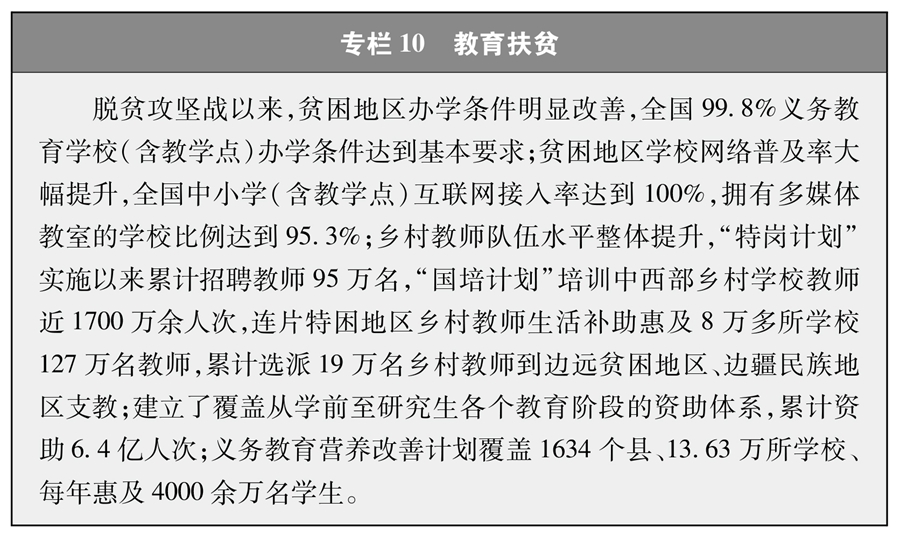
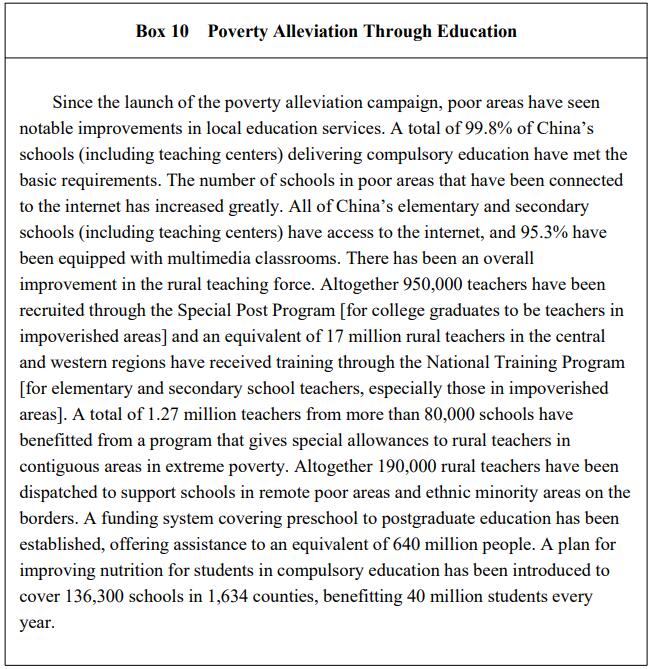
社会保障兜底一批。聚焦特殊贫困群体,落实兜底保障政策。实施特困人员供养服务设施改造提升工程,集中供养能力显著增强。农村低保制度与扶贫政策有效衔接,全国农村低保标准从2012年每人每年2068元提高到2020年5962元,提高188.3%。扶贫部门与民政部门定期开展数据比对、摸排核实,实现贫困人口“应保尽保”。
Fifth, providing subsistence allowances for those unable to shake off poverty through their own efforts alone. China focuses on the needs of the most vulnerable groups and provides them with subsistence allowances. Services and facilities to support people living in extreme poverty have been upgraded, with a greater capacity to provide care in service centers. The rural subsistence allowances framework has been effectively dovetailed with poverty alleviation policies, and the per capita yearly subsistence allowances in rural areas had grown from RMB2,068 in 2012 to RMB5,962 in 2020, an increase of 188.3%. The departments in charge of poverty alleviation and civil affairs compare data and verify information on a regular basis, to ensure full coverage of support for eligible groups.
中国还结合实际、因地制宜,采取其他多渠道多元化扶贫措施。大力推进就业扶贫,通过免费开展职业技能培训、东西部扶贫协作劳务输出、扶贫车间和扶贫龙头企业吸纳、返乡创业带动、扶贫公益性岗位安置等形式,支持有劳动能力的贫困人口在本地或外出务工、创业,贫困劳动力务工规模从2015年的1227万人增加到2020年的3243万人。开展健康扶贫工程,把健康扶贫作为脱贫攻坚重要举措,防止因病致贫返贫(专栏11)。深入实施网络扶贫工程,支持贫困地区特别是“三区三州”等深度贫困地区,完善网络覆盖,推进“互联网+”扶贫模式。实施资产收益扶贫,把中央财政专项扶贫资金和其他涉农资金投入设施农业、光伏、乡村旅游等项目形成的资产,折股量化到贫困村,推动产业发展,增加群众收入,破解村集体经济收入难题。2020年新冠肺炎疫情发生后,中国采取一系列应对疫情的帮扶举措,加大就业稳岗力度,开展消费扶贫行动,有效克服了新冠肺炎疫情影响。
China has also implemented many other forms of support for poverty alleviation that are consistent with local conditions. The government has redoubled its efforts to boost employment for the poor, through means such as offering free training on vocational skills, strengthening collaboration in the labor market between the eastern and western regions, supporting leading enterprises and workshops in poverty alleviation to create more jobs, encouraging entrepreneurial individuals to start businesses in their hometowns or villages, and creating public welfare jobs for the rest of the unemployed. Poor people who have the ability to work are encouraged to find employment locally or elsewhere, or start their own businesses. In 2015, 12.27 million poor laborers found employment; the figure had risen to 32.43 million in 2020. China has made efforts to improve healthcare service to the poor, considering it an important part of poverty alleviation in order to prevent the poor from sinking back into poverty due to illness (Box 11). China has launched a project to connect poor areas to the internet, introducing the "internet+" model for poverty alleviation in poor areas, especially in the extremely impoverished "three areas and three prefectures". The earnings from poverty alleviation funds and assets have been used to support the poor. The assets generated from facility agriculture – agriculture making extensive use of polytents and other similar equipment – PV power stations, and rural tourism using central government funds for poverty alleviation and other agriculture-related funds have been converted into shares and allocated proportionately to poor villages in order to give a boost to businesses, increase villagers' incomes and more importantly help solve the problem of generating revenue for the villages' collective economy. Since Covid-19 struck in 2020, China has adopted a series of support measures, such as measures to stabilize employment and encourage consumption of products from poor areas, effectively minimizing the impact of the virus.
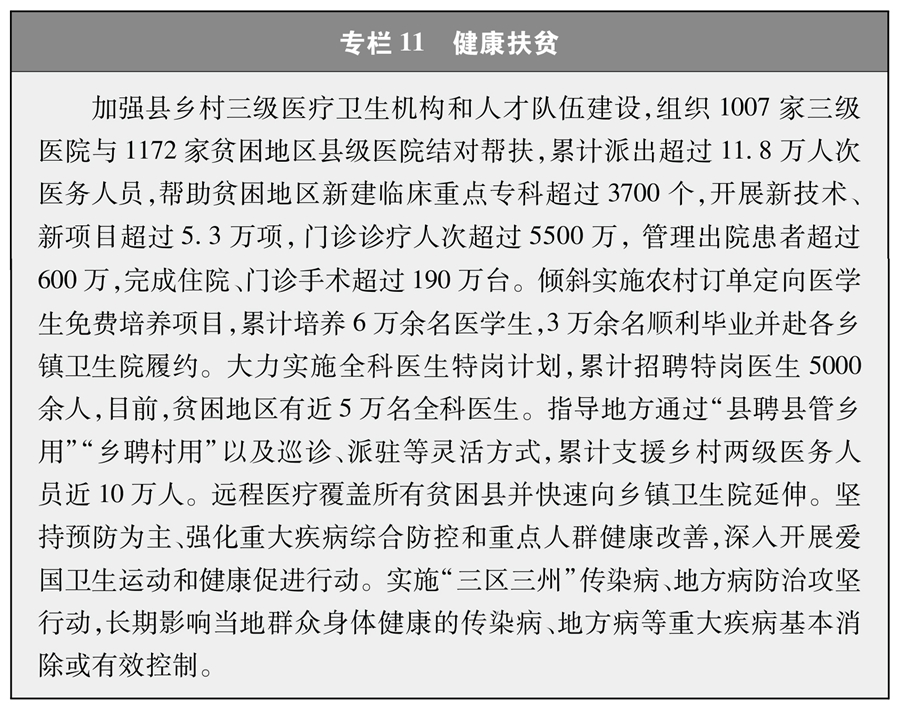
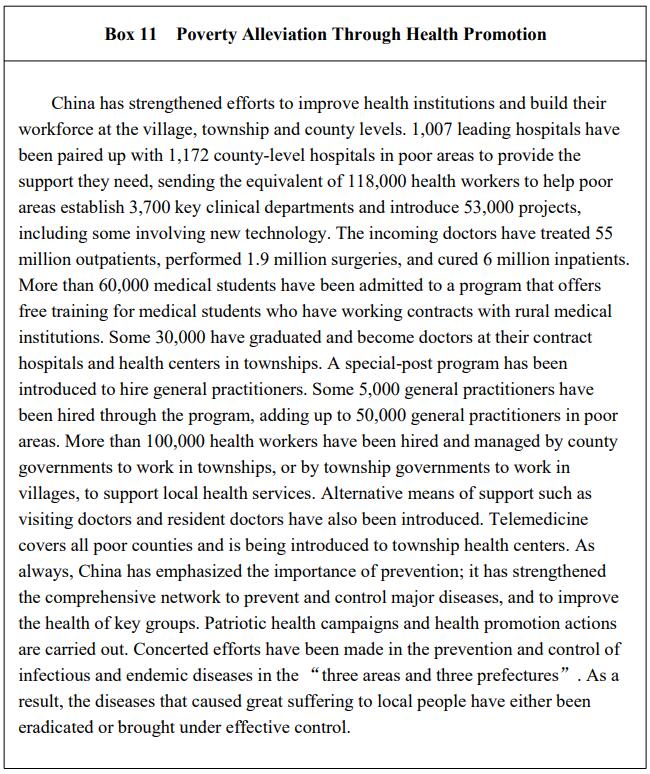
(四)严格标准、有序退出,解决“如何退”的问题
4. Adopting Strict Criteria to Know When and How to Deregister Those Who Have Emerged from Poverty
建立贫困退出机制,明确贫困县、贫困村、贫困人口退出的标准和程序,既防止数字脱贫、虚假脱贫等“被脱贫”,也防止达到标准不愿退出等“该退不退”。制定脱贫摘帽规划和年度减贫计划,确保规范合理有序退出。严格执行退出标准,严格规范工作流程,贫困人口退出实行民主评议,贫困村、贫困县退出进行审核审查,退出结果公示公告,让群众参与评价,做到程序公开、数据准确、档案完整、结果公正。强化监督检查,每年委托第三方对摘帽县和脱贫人口进行专项评估,重点抽选条件较差、基础薄弱的偏远地区,重点评估脱贫人口退出准确率、摘帽县贫困发生率、群众帮扶满意度,确保退出结果真实。2020年至2021年初,开展国家脱贫攻坚普查,全面准确摸清贫困人口脱贫实现情况。贫困人口、贫困村、贫困县退出后,在一定时期内原有扶持政策保持不变,摘帽不摘责任,摘帽不摘帮扶,摘帽不摘政策,摘帽不摘监管,留出缓冲期,确保稳定脱贫。
A poverty exit mechanism has been established, with clear provisions on the standards and procedures for deregistering from the list poor counties, villages, and individuals. This prevents misconduct such as manipulation and falsification of data, and also prevents those who have emerged from poverty from keeping the label in order to continue accessing preferential treatment. The government has worked out a poverty deregistration plan and an annual poverty alleviation plan to ensure procedure-based, rational and orderly exit from the registers. The criteria and procedures have been strictly enforced, for example, by conducting public review in the case of individuals and government examination in the case of villages and counties. The results of poverty exit have been disclosed for public evaluation and review, based on transparent procedures, accurate data and complete files, to ensure fairness. Supervision and inspection have been strengthened, including annual evaluations by third parties of the deregistered population and counties, with a focus on remote areas with weaker economic foundations. Three parameters – the accuracy of decisions, the poverty incidence of recurrence among deregistered counties, and public rating of assistance measures – are emphasized in evaluation, to ensure accurate results. From 2020 to early 2021, China conducted a general survey of poverty elimination, collecting accurate data on progress in helping the poor out of poverty. A "grace period" is allowed for previously impoverished population, villages and counties, during which time poverty alleviation policies and government supervision are continued until their status is secure.
(五)跟踪监测、防止返贫,解决“如何稳”的问题
5. Conducting Follow-up Monitoring to Help People Stay Out of Poverty
稳定脱贫不返贫才是真脱贫。对脱贫县,从脱贫之日起设立5年过渡期,过渡期内保持主要帮扶政策总体稳定,对现有帮扶政策逐项分类优化调整,逐步由集中资源支持脱贫攻坚向全面推进乡村振兴平稳过渡。健全防止返贫动态监测和帮扶机制,对脱贫不稳定户、边缘易致贫户,以及因病因灾因意外事故等刚性支出较大或收入大幅缩减导致基本生活出现严重困难户,开展定期检查、动态管理,做到早发现、早干预、早帮扶,防止返贫和产生新的贫困。继续支持脱贫地区乡村特色产业发展壮大,持续促进脱贫人口稳定就业。做好易地搬迁后续扶持,多渠道促进就业,强化社会管理,促进社会融入,确保搬迁群众稳得住、有就业、逐步能致富。坚持和完善驻村第一书记和工作队、东西部协作、对口支援、社会帮扶等制度。继续加强扶志扶智,激励和引导脱贫群众靠自己努力过上更好生活。开展巩固脱贫成果后评估工作,压紧压实各级党委和政府责任,坚决守住不发生规模性返贫的底线。
People and locations will only be considered to have shaken off poverty when they have stayed out of it and have not fallen back in after a certain period. Counties have been given a five-year period of grace from the day they emerged from poverty. During this period they will continue to enjoy the main support policies, which will be adjusted and optimized by category. Over time the resources leveraged for intensive poverty elimination will be redirected towards an extensive drive for rural revitalization. China will improve its dynamic monitoring of any trends indicating a return to poverty, and improve associated support measures. It will regularly check on key groups, such as those who have just emerged from poverty but whose position is far from secure, those on the verge of poverty who can fall back in again easily, and those experiencing difficulties in meeting their basic needs due to expenditure induced by illness, disaster or accident, or due to a sharp drop in income, and exercise dynamic management to spot these trends early and intervene through support measures, so that these people do not fall back into poverty. China will continue to support formerly impoverished areas in developing their specialty industries and help those who have emerged from poverty have stable employment. Follow-up support will be given to the resettled population whose employment will be promoted through multiple means. The government will improve social management to help them integrate into society, so that they will stay out of poverty, remain employed and have a promising future. Systems and practices that have proven effective, such as resident first secretaries and working teams, eastern-western collaboration, paired-up assistance, and social assistance, will be continued and improved. Efforts will be intensified to help those who have emerged from poverty build up self-belief and have access to education, so that they can create a better life through their own hard work. More evaluation will be carried out over the status of formerly impoverished people and areas, and Party committees and governments at all levels will continue to take responsibility to ensure that people do not sink back into poverty in large numbers.
精准扶贫方略,是中国打赢脱贫攻坚战的制胜法宝,是中国减贫理论和实践的重大创新,体现了中国共产党一切从实际出发、遵循事物发展规律的科学态度,面对新矛盾新问题大胆闯、大胆试的创新勇气,对共产党执政规律、社会主义建设规律、人类社会发展规律的不懈探索,对实现人的全面发展和全体人民共同富裕的远大追求。精准扶贫方略,不仅确保了脱贫攻坚取得全面胜利,而且有力提升了国家治理体系和治理能力现代化水平,丰富和发展了新时代中国共产党执政理念和治国方略。
The strategy of targeted poverty alleviation is China's strongest weapon in its final battle to secure victory against poverty, and a major innovation in the theory and practice of poverty alleviation. It highlights the CPC's sound approach whereby all actions are based on actual conditions and conform to the needs of development; it is a manifestation of its courage to face up to new challenges and find solutions through trial and error; of its tireless exploration of the characteristics of governance by the CPC, the development of socialism, and the evolution of human society; and of its pursuit of all-round development of the people and common prosperity for all. In addition to securing a sweeping victory in the final battle against poverty, the strategy has also given a powerful boost to modernizing China's national governance system and capacity, and to enriching and developing the CPC's guiding philosophies and governance strategies in the new era.









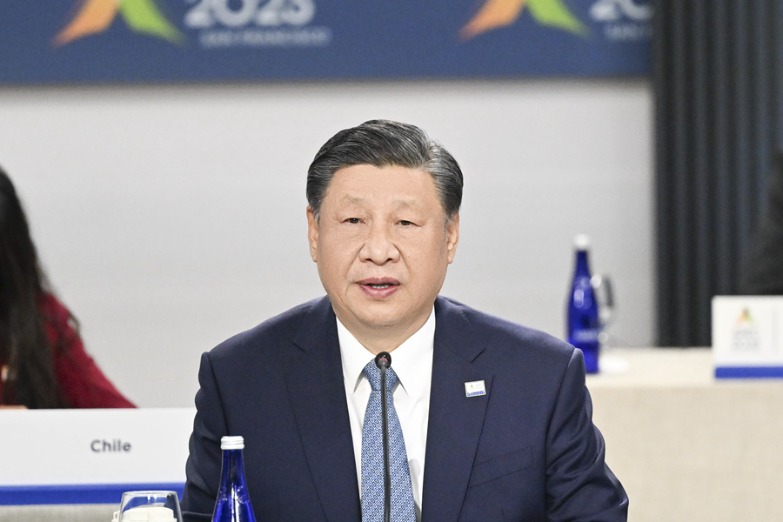

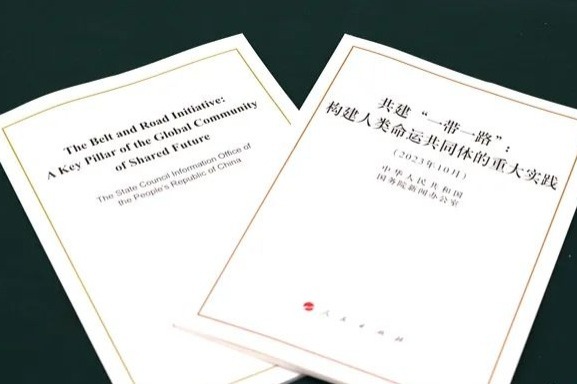
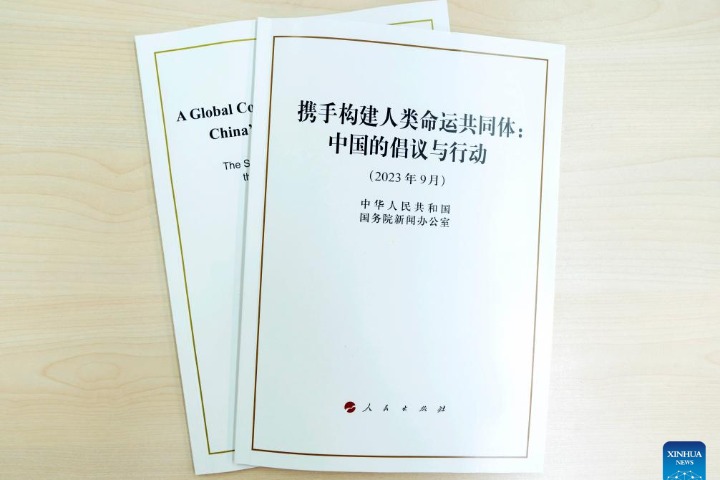
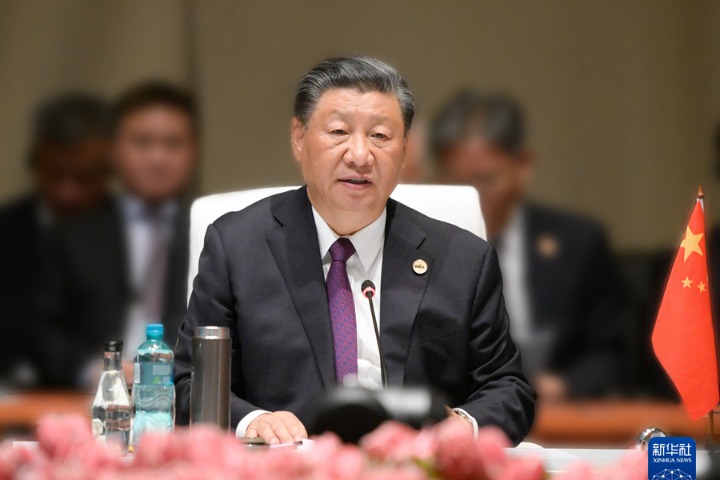



 英语点津微信
英语点津微信 双语小程序
双语小程序